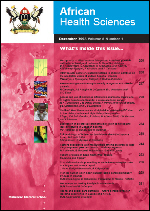
|
African Health Sciences
Makerere University Medical School
ISSN: 1680-6905
EISSN: 1680-6905
Vol. 16, No. 1, 2016, pp. 83-88
|
 Bioline Code: hs16012
Bioline Code: hs16012
Full paper language: English
Document type: Research Article
Document available free of charge
|
|
|
African Health Sciences, Vol. 16, No. 1, 2016, pp. 83-88
| en |
Hookworm-like eggs in children’s faecal samples from a rural area of Rwanda.
Irisarri-Gutiérrez, María José; Muñoz-Antolí, Carla; Acosta, Lucrecia; Parker, Lucy Anne; Toledo, Rafael; Bornay-Llinares, Fernando Jorge & Esteban, José Guillermo
Abstract
Background: Hookworm eggs identification and quantification is usually carried out by Kato-Katz method. However various structures present in the smear may be confused with eggs of such parasites.
Objective: To document the presence of structures in Kato-Katz slides that could initially be misinterpreted as hookworm eggs.
Method: 497 faecal samples were analysed by Kato-Katz technique, diphasic concentration technique, agar-plate coprocultive and larvae obtained were analysed by PCR and characterized by sequencing.
Results: Hookworm-like eggs were found in 159 (32%) of the samples by Kato-Katz, finally identified as Caenorhabditis elegans by PCR technique.
Conclusion: The diagnosis of human hookworm eggs, only by the use of Kato-Katz technique can lead to false positives because of similarities with eggs of other free-living worms, from wet soils like those of Rwanda that could contaminate stool samples.
Keywords
Hookworm eggs; Kato-Katz method; misclassification; Rwanda
|
| |
© Copyright 2016 - African Health Sciences
|
|
